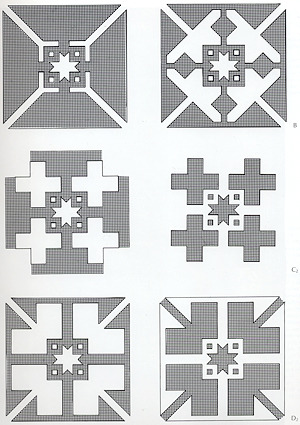Hi All
Well I will just pursue my mini anti-Gantzhorn crusade for one more post.
(and I will try to remember writing Volkmar Gantzhorns full name a lot when I criticize him, in the hope that the search engines will pick it up, probably a futile little battle against all the good offers from f.ex amazon.com

)
Volkmar Gantzhorn uses a serie of very basic squared cross variations to categorize all rug types. The crosses do at the same time, according to Volkmar Gantzhorn, correspond to christian armenian ornamentation:

This is of course in itself a highly questionable method of categorization, but the actual way that Volkmar Gantzhorn uses and misuses his own method on specific non-cruciform patterns is even more questionable. Here is an example:

To make this very important 13th c Seljuk Kufic border fit into an Armenian context Volkmar Gantzhorn has to fantasize that the motif is a distorted half of another pattern which coincidently must have looked like an Armenian cross. This is in my opinion a highly disingenuously approach towards the simple fact that Seljuk pattern exist as it is, and of course primarily should be put into the context of other relevant existing patterns and motifs - and not imagined or non existing patterns.
Another example where Gantzhorn compares a geometric pattern from an Il-Khanid miniature with a minor border from a Seljuk rug:

Volkmar Gantzhorn starting point regarding the simple and very generic geometric Il-Khanid border is this:
"Needless to say, what we have here is clearly a Christian symbol, in fact one of the most common among the monophysites in Armenia". In itself a gross overinterpretation of this fine little generic Il-khanid pattern, which of course might as well be turned 180 degree, making it something completely different from a cross on a hill - and turning the whole illustration the 180 degree would actually also show the Seljuk minor border as what it is: a miniature version of the larger Kufic motifs on the Seljuk main borders.
best
Martin